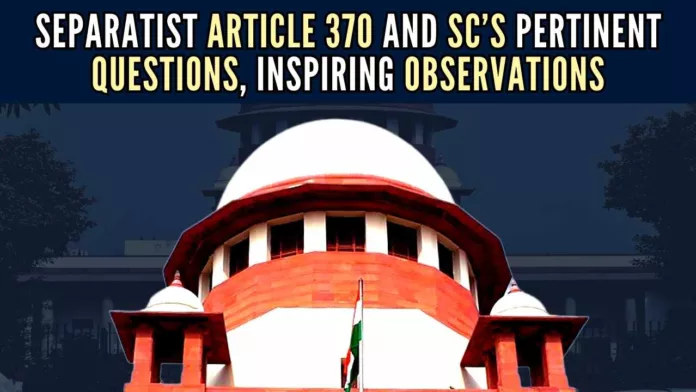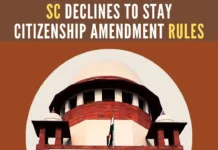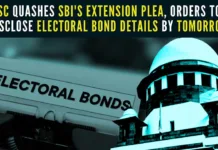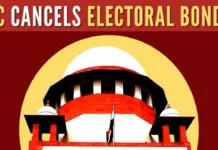
SC rulings on Jammu and Kashmir special status
A five-judge constitution bench headed by Chief Justice D Y Chandrachud on August 2, 3, 8, 9, and 10 heard a batch of pleas (23 in number) challenging the Narendra Modi government’s August 5, 2019, historic decision to abrogate Article 370/ J&K’s communal status, scrap unconstitutional Article 35A and create out of J&K Union Territories of J&K and Ladakh. Other members of the bench were Justices Sanjay Kishan Kaul, Sanjiv Khanna, B R Gavai, and Surya Kant. The decision changed the whole course of the political history of J&K with one stroke of pen in the sense that it was brought at par with other states of the country. The next date of the hearing is August 16.
Seeking revival of Islamic Republic of J&K
It was expected that the landmark decision will rattle Kashmiri separatists of all hues and their supporters outside Kashmir, including one former Union Home Secretary, G K Pillai; one retired Major General, Ashok Mehta; one retired Air Force official and a Kashmiri Kapil Kak; and former interlocutor, Radha Kumar, and it did happen. They all approached the apex court and sought reversal of the reform scheme as introduced by the Modi government so that the demolished edifice of the Islamic Republic of J&K reconstructed and Islamists continued to hurt and bleed the nation and eliminate minorities such as Hindus, Buddhists, and Sikhs.
Separatists’ lawyers’ basic arguments
Kapil Sibal’s arguments: “Through a political act Article 370 was tossed out of the window. This was not a constitutional act. Parliament took upon itself the role of Constituent Assembly and revoked Article 370 saying it is exercising the will of the people of Jammu and Kashmir. Can such a power be exercised?… After the Constituent Assembly for the erstwhile state of J&K ceased to exist in 1957, there was no constitutional process left to touch Article 370…This (Article 370) is not a basic structure (of the constitution). This is a compact between one sovereign and another drafted in our constitution. It’s a constitutional compact, unlike other states…Junagadh didn’t agree and had to be taken over…You can’t introduce a Bill in Parliament at 11 o’clock, pass a resolution without anyone knowing about it…Why? Because you are subject to the constraints of the Constitution…The Governor and the government were acting in tandem. They wanted to get rid of Article 370…This is an amazing piece of handiwork…The Parliament of India could not assume the powers of the non-existent Constituent Assembly and abrogated Article 370…It’s a mosaic of illegalities attractive enough to be junked…The consent of J&K was not taken… It (abrogation of Article 370) can happen as a political decision, the J&K government and state legislature unanimously decide…There is no other way out…There was an understanding between the constitution framers and then Maharaja of J&K Hari Singh, who was in favour of the independence of his state, signed an Instrument of Accession to India due to the trouble caused by Pakistani infiltrators, under which Article 370 was inserted and no process can now be followed to abrogate it…The abrogation of Article 370 was a political act like Brexit where the opinion of British citizens was elicited through a referendum. This was not the case when Article 370 was repealed…” (Brexit was the name given to the United Kingdom’s departure from the European Union (EU). Britain’s exit from the EU was “actuated by a rise in nationalistic fervor, daunting immigration issues, and a distressed economy”.)
Gopal Subramanium’s arguments: “Even though the word ‘temporary’ appears in the marginal notes of Article 370 of the Constitution, the resolution passed by the J&K Constituent Assembly said that the Constitution of India must apply with these modifications. The Constitution of J&K and the Indian Constitution were speaking to each other through Article 370…Article 370 was not a repository of untrammelled power but a medium through which the constitution would apply to the erstwhile State of J&K…Article 370 ought not to be read or interpreted as an expression of power politics or a bargaining chip. Rather, it should be interpreted as a principled compact between the people of India (acting in their constituent capacity through the Indian Constituent Assembly) and the people of the State of J&K…The impugned orders – Constitution Orders- 272 (issued on August 5, 2019) and Constitution Order- 273 (issued on August 6, 2019)- in sum and substance do away with the Constitution of J&K. That is impermissible, not authorized under the law…The Constituent Assembly of J&K have expressly affirmed by a resolution that they don’t want Article 370 of the Indian Constitution to be abrogated as they wanted the provision to be a language of communication between the two Constitutions of India and J&K…If the Constituent Assembly of J&K, which is the body of people, has taken these proactive steps and we have accepted those proactive steps, can we unilaterally abrogate this arrangement?”…This arrangement between J&K and India was a compact of federalism and Article 370 establishes the contours of this relationship in the federal sense…”
Zaffar Shah’s argument: Contending on behalf of the J&K Bar Association (Kashmir wing), Zaffar Shah argued: “J&K had constitutional autonomy which came from the Instrument of Accession and Article 370. If you want to completely integrate, then a merger agreement has to be executed…The President and the Union (of India) can make laws for any state in the country without their view but not for J&K…The genesis of the Constitution of J&K is in the Instrument of Accession and the order of proclamation. The first part of Article 370 talks of the application of laws in List 1, list 2, list 3…It mentions consulting…Consult does not mean agree…you may disagree also…I (J&K) still have constitutional autonomy, maybe a little. Maybe, it’s a skeleton as Justice Kaul said…But somebody felt that the skeleton was disturbing him. Therefore, he got it off…The then Governor of J&K had committed a ‘serious Constitutional misconduct’ in 2019 by recommending the abrogation of Article 370 to the President… Constitutionally speaking, there is no power vested in the Central Government or in the President to make any laws for the erstwhile state…Unlike J&K, neither consultation nor concurrence was required for framing of laws with regard to other States…For complete integration of J&K with India, one had to get rid of the Instrument of Accession signed on October 26, 1947, as well as Article 370, and execute a merger agreement…Limitations were provided in Article 370 itself with regard to the powers of Parliament to make laws for J&K, if the Centre intended to make any law on a subject which was not covered under the Instrument of Accession, the concurrence of the state government was required…Special status was accorded to J&K because there was no merger agreement and the state’s autonomy had to be maintained…”
The basic upshots of the arguments advanced by Sibal, Subramanium, and Shah were: Article 370 was a permanent feature of the constitution; it’s a compact between J&K and India; J&K was a “new category beyond the basic structure of the Constitution”; and President and Parliament had no power whatsoever to alter, amend or abrogate Article 370.
CJ Chandrachud’s questions, observations
“What happens when the tenure of Constituent Assembly comes to an end? No Constituent Assembly can have an indefinite life. The proviso to clause (3) of Article 370 refers to the recommendation of the Constituent Assembly of the state, and it says before President issues a notification the recommendation of the Constituent Assembly is required. But the question is what would happen when the Constituent Assembly ceases to exist?”…It can’t be that because there is no Constituent Assembly, you cannot at all deliberate on a proposal for abrogation or modification of Article 370…You (Sibal) are saying, therefore, that there is a provision of the constitution which lies even beyond the amending power of Parliament. So we are then creating a new category, apart from basic structure, and Article 370 belongs to that?… We are treading on thin ice. Because the moment we say this (Article 370) was just a recognition of a compact between one sovereign state and another which forms part of our constitution, then such a sovereign compact is capable of being overridden by the sovereign of the succeeding state… Article 368 says, the power of Parliament to amend the constitution and procedure therefore: (1) notwithstanding anything in the constitution, Parliament may in the exercise of its constituent power amend by way of addition, variation, or repeal any provision of this constitution in accordance with the procedure laid down in the Article…Within a constitution like ours, there is no question of a referendum…In a constitutional democracy, seeking the opinion of the people has to be done through established institutions. So long as a democracy exists as it does, in terms of constitutional democracy, any recourse to the will of the of people has to be expressed and sought through established institutions…You (Sibal) cannot envisage a situation like Brexit type of referendum…How could Article 370, which was envisaged as a temporary provision, be converted into a permanent provision merely by proceedings of the J&K Assembly…Once a proclamation takes place under Article 356, two things follow – One, the President gets all powers of the state. Two, the power of state legislature is subsumed in Parliament. So once the proclamation under Article 356 was issued – all powers vested in the executive of J&K were transferred to the Union government. All powers of the state legislature were vested in Parliament. Then if Article 370 (3) is capable of interpretation, just as a hypothesis, that the power of abrogate is the President…If the Union Government had to abrogate Article 370 why was an amendment to Article 376 required at all…Once it is assumed that the Parliament can amend Article 370 then such amendment of Article 370 would be subject to criticism on the ground of morality but not on the basis of a lack of authority…The surrender of J&K’s sovereignty to India was ‘absolutely complete’ with the accession of the former princely State in October 1947, and it is ‘really difficult’ to say that Article 370 of the Constitution, which accorded special status to the erstwhile state, was permanent in nature…Once Article 1 of the Constitution says India shall be a Union of States, including J&K, the transfer of sovereignty was complete in all respects…One thing is very clear there was no conditional surrender of the sovereignty of J&K with India. Once sovereignty was absolutely vested in India, the only restraint was on the power of Parliament to enact laws (in respect of the state)…
We cannot read the post Article 370 Constitution as a document that retains some element of sovereignty in J&K…Restraint on the power to enact legislation is implicit in the scheme of the constitution because we don’t have a unitary state. But does that retract from sovereignty? No. It’s just a fetter on Parliament…Concurrence is not something unique only with regard to the country’s relationship with J&K…Though there are restraints on the power of Parliament to make laws for states on subjects falling in the state list, the distribution of legislative powers does not affect the fact that the sovereignty vests in India…There are various shades of concurrence required under the constitution and they don’t reflect on the sovereignty of the Union…Article 246A has completely redefined our notions of sovereignty as states are given a vital role in financial matters…Our notion of parliamentary exclusion from states has been an evolving exercise. But one thing is clear, the sovereignty of J&K was ceded completely to the Union of India…”
Justice Gavai’s question
“Is he (Sibal) saying that from 1957, Clause 3 of Article 370 has become otiose…?”
Justice Kaul’s questions, observations
“The Constitution is a live document and it is not static. Can you (Sibal) say there is no mechanism to change it (Article 370) even when everyone wants to change it? Then you (Sibal) are saying that this can’t be changed even if all of Kashmir wants it…The real issue is whether the process adopted by the Centre for abrogating Article 370 was permissible or not. To say that Article 370 is permanent is really difficult. Suppose the state itself says that we want all laws (prevailing elsewhere in the country) to apply, then where does Article 370 go? Then, we really come back to the main question of the process (where Parliament can repeal Article 370). Was this process permissible or not?… If that machinery (Constituent Assembly) was to be recreated, then Article 370 could be removed?…”
Justice Khanna’s observations
“One may call it a J&K Constitution but in essence what was adopted was an Indian Constitution with certain exceptions and modifications…By its very nature, Article 370 is very flexible. Normally constitutions are flexible with time and space because they’re made once but they last for a longer period…Complete integration (of J&K) has already taken place as per Article 1 of the Constitution…”
Conclusion
The questions put and observations made by Chief Justice Chandrachud and Justices Gavai, Kaul, and Khanna all serve to demonstrate that the arguments advanced by Sibal, Subramanium, and Shah were as untenable as they were based on mere conjectures and communally motivated. Their whole approach was divisive, unsettling, and calculated to according a dangerous respectability to the cult of separatism, based on religious fanaticism. There was no compact between the Maharaja of J&K and the Dominion government. He alone had the authority to decide the political fate of his state under the Indian Independence Act of 1947 and he exercised his authority in favour of India. He didn’t sign an Instrument of Accession which was different from the ones signed by other princely states. Similarly, J&K, unlike other princely states like Patiala, Kapurthala, and Hill States in Himachal, was the largest princely state and, hence the question of its merger with any state didn’t arise. I would agree with those who opine that “Article 370 was the illegitimate child produced by JL Nehru and Sheikh Abdullah”.
All in all, it can be said that things are moving in the right direction. Let’s all hope for the best.
Note:
1. Text in Blue points to additional data on the topic.
2. The views expressed here are those of the author and do not necessarily represent or reflect the views of PGurus.
PGurus is now on Telegram. Click here to join our channel and stay updated with all the latest news and views
For all the latest updates, download PGurus App.











We have people willing to sell their soles for money that do not need.
Excellent summary, thanks Prof Hari Om!